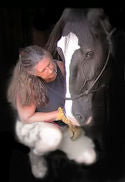Contracted Heels?
Contracted Heels -- just what ARE contracted heels on a horse's hoof?
Well, basically, if the heel measurement is less than the toe measurement, the heels are said to be contracted.

So, that's pretty straight forward, wouldn't you say?
Alternatively, if the width of the frog is less than 67% of the length of the frog then the heel is said to also be contracted.
And, to muddy the waters even more, some horses are congenitally predisposed to appear to have contracted heels OR, have adapted to environmental or mechanical influences leaving the heels seemingly contracted.
Got that? It really is pretty simple and the hoof, itself, will tell you just by looking at it.
Compare the two hooves below -- the first is a healthy, strong hoof with good heels:


Can you see the difference between these two hooves? The frog in the first photo is as wide at the back as the hoof is wide 1" back from the toes. In the 2nd photo it is clear that the frog is severely contracted and not even close to being as wide as the measurement at the toe.
So what, you ask? So what if the heels are contracted? My horse seems perfectly fine.
While contracted heels occur more frequently in shod horses, there are plenty of barefooted horses who are equally as contracted. The results can be or will be sore hooves that are predisposed to central sulcus infections, thrush or even canker The end result being a horse that is destined to remain a paddock potato or worse if the situation is not remedied.
What causes Contracted Heels?
There are actually two main factors that cause contracted heels: high heels and lack of engagement of the back of the hoof. As the heel grows higher, the frog loses the contact with the ground that will cause contraction of the heels over time. The frog will then become even less engaged thus leading to infections. Another factor that contributes to contracted heels are heels that are too low, causing more forward growth of the toes, causing a delay in the breakover which results in long-toe-low heel syndrome - the hoof elongates from the toe to the heel and as a result, the heels will generally grow closer to one another.
The hooves with contracted heels are weak, particularly in the back of the hoof.
Lack of sufficient movement/exercise results in diminished blood flow to the back of the hoof which causes a drop in the moisture content of the entire hoof capsule. The resulting contraction can compress the sensitive inner structure of the hoof and then cause lameness or soreness. (Studies indicate there are proprioceptive receptors in the buttress of the frog indicating that frog contact with the ground or pressure in important in proper development of the heel growth. These studies indicate that the rear portion of the frog is necessary for full sensory perception of the barefoot horse. Constant contact of the frog on the ground is detrimental in that it decreases the blood flow to the hoof but, on the other hand, when the frog buttress contacts the ground only before the foot is fully loaded during a correct, heel-first landing, the heels and frog can grow healthy and sound.
Proper balanced trimming of the heels combined with a proper, species-specific diet of all forage and sufficient exercise will easily correct contracted hooves. If infection has set in then appropriate treatment must be applied, as well as the proper trimming, diet and exercise.
If these measures do not correct the situation then a closer look at possible mineral deficiencies must be considered, explored and resolved.

Building a Supportive Barefoot Community
The team at Scoot Boot believe passionately in the barefoot horse and strive to build a supportive community of barefoot horse lovers.
Find more information about using Scoot Boots here.

Gwen Santagate is the author of "10 Secrets to Healthy Hooves" . For the last 37+ years, she has maintained healthy hooves with natural trimming on thousands of horses and specialized in pathological rehabilitation hoofcare for the last 18 years. She keeps a small herd of her own equines and continues to offer consults for horses in need.
